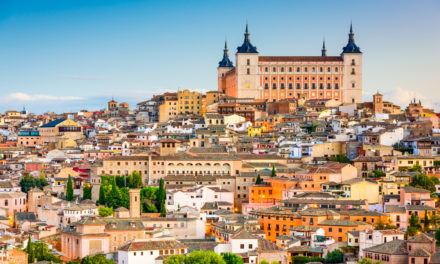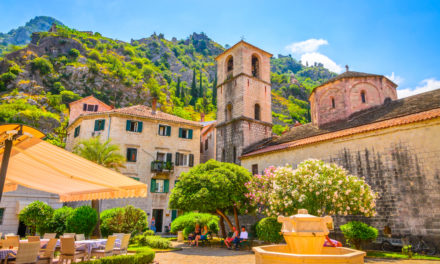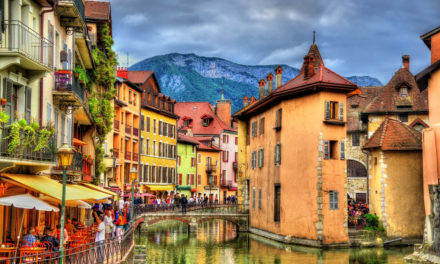Top Tourist Attractions And Things To Do In Turkey
Turkey is a transcontinental country located in Western Asia and Southeast Europe.
Antalya, known as the gateway of the “Turkish Riviera,” is a popular destination for its beautiful beaches, old harbor, and quaint Old Town. Istanbul, the largest city and main financial center, is famous for its rich history, culture, and architecture. Other popular destinations include Konya, Ephesus, Göreme, Ankara, and more. Turkey has many different types of land, like mountains, beaches, jungles, and forests. It is one of the top tourist destination in the world.
Tourist Travel Map of Turkey
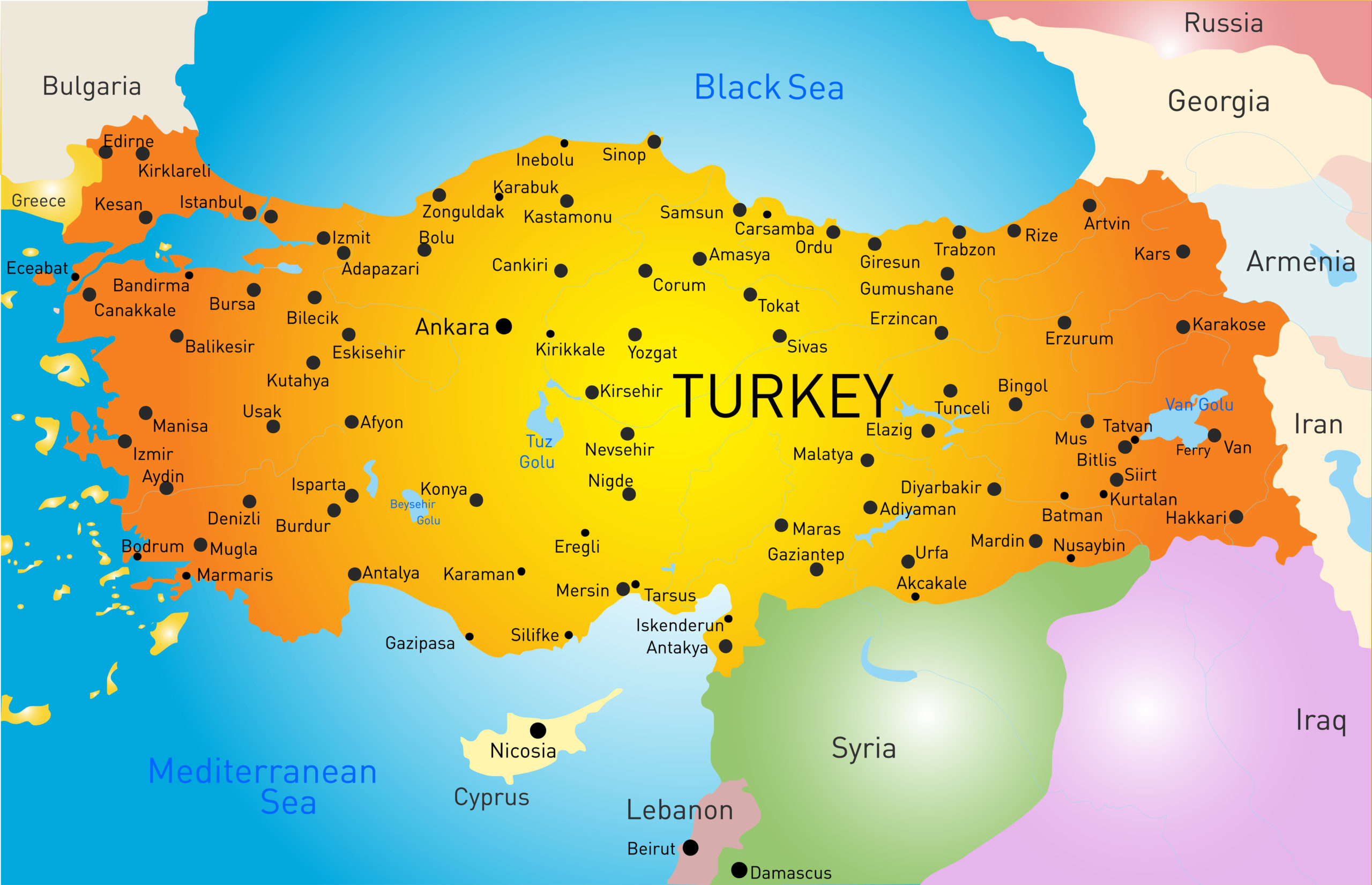
Best Places To Visit In Turkey
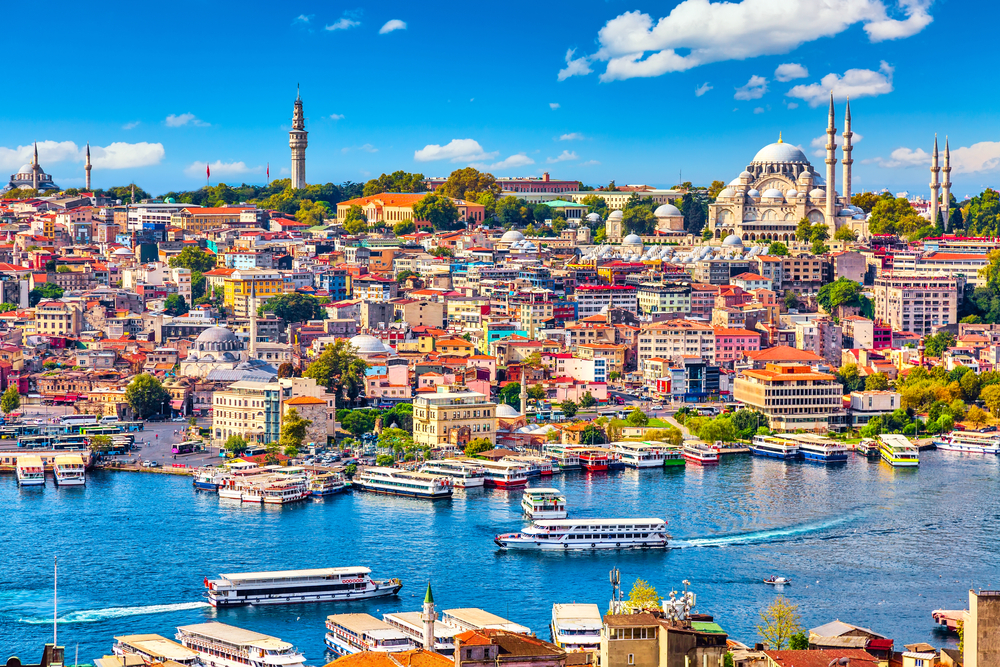
Istanbul, Turkey:
Istanbul, a city spanning two continents, is a captivating blend of rich history and diverse culture. Its skyline, punctuated by minarets and domes, narrates stories of empires while bustling bazaars and modern boutiques embody the city’s vibrant energy. Istanbul invites travelers to explore its rich heritage at the crossroads of Europe and Asia.
Tourist attractions and things to do in Istanbul, Turkey:
- Hagia Sophia (Ayasofya): Originally a cathedral, later a mosque, and now a museum, the Hagia Sophia is a testament to Istanbul’s layered history and is famed for its massive dome and stunning mosaics.
- The Blue Mosque (Sultanahmet Camii): Known for its striking blue tiles that adorn its interior walls, the Blue Mosque remains an active place of worship while being a major tourist attraction. Its courtyard is particularly serene at night.
- Topkapi Palace (Topkapı Sarayı): Once the court of the Ottoman Empire, today it’s a museum that exhibits imperial collections, including the Prophet Muhammad’s cloak and sword. The harem is also a must-see for an additional fee.
- Grand Bazaar (Kapalıçarşı): One of the largest and oldest covered markets in the world with over 4,000 shops, the Grand Bazaar is a bustling maze of streets and passages selling everything from spices to gold.
- Bosphorus Strait: The strait that separates Europe from Asia offers scenic ferry rides, providing views of the city’s skyline, palaces, fortresses, and hillsides lined with houses, particularly beautiful at sunset.

Cappadocia, Turkey:
Cappadocia is a beautiful region in Turkey known for its rugged terrain and rich ancient history. Eroded volcanic rock formations, called “fairy chimneys,” create a surreal lunar-like environment. Hot air balloons gracefully float above, offering breathtaking vistas of this unique wonderland. Underground cities carved into the soft rock reveal the ingenuity of ancient civilizations.
Cappadocia’s rich cultural heritage, with its Byzantine-era cave churches adorned with intricate frescoes, adds depth to the experience. Adventurous souls can explore hidden valleys, hike through surreal canyons, and savor traditional Turkish cuisine in charming villages. Cappadocia’s timeless allure captures the imagination, making it a must-visit destination for those seeking natural and historical marvels.
Tourist attractions and things to do in Cappadocia, Turkey:
- Hot Air Ballooning: The most iconic activity in Cappadocia is taking a hot air balloon ride over the unique rock formations, known as “fairy chimneys,” and the beautiful valleys at sunrise.
- Göreme Open-Air Museum: This World Heritage site is an essential visit, featuring rock-cut churches, chapels, and monasteries adorned with Byzantine frescoes dating back to the 10th century.
- Underground Cities of Kaymaklı and Derinkuyu: These ancient underground complexes are several levels deep, with elaborate systems of passages, rooms, and halls that provided refuge for early Christians.
- Pasabag (Monk’s Valley) and Devrent (Imagination Valley): Both valleys are famous for their stunning natural rock formations. Pasabag contains some of the most striking fairy chimneys in Cappadocia, with twin and even triple rock caps.
- Uçhisar Castle: The highest point in Cappadocia, Uçhisar Castle offers a magnificent panoramic view of the surrounding area. The castle and its surroundings contain numerous carved out rooms and tunnels that you can explore.

Pamukkale, Turkey:
Pamukkale is a stunning natural wonder in Turkey that will surely delight you with its ethereal beauty. This beautiful destination, known for its lovely terraces of white mineral-rich pools, is a testament to the Earth’s geological wonders. Here, calcium deposits have created cascading thermal pools that seem like something out of a dream.
Visitors can soak in the refreshing thermal waters while gazing at the picturesque landscape. You can explore the ancient city of Hierapolis, with its well-preserved ruins and history dating back to Roman times. Pamukkale offers a unique blend of natural splendor and historical significance, making it a must-visit destination in Turkey.
Tourist attractions and things to do in Pamukkale, Turkey:
- Travertines: These terraces are made of travertine, a sedimentary rock deposited by water from the hot springs, famed for their white cotton-like appearance. Visitors can walk in the warm waters along a designated path.
- Hierapolis Archaeological Site: Adjacent to the travertines, the ruins of the ancient Greco-Roman and Byzantine city of Hierapolis provide a historical context to the natural wonders of Pamukkale, including a well-preserved theater and necropolis.
- Cleopatra’s Pool (Antique Pool): A geothermal spring where you can swim among ancient Roman ruins, believed to have been a gift from Marc Antony to Cleopatra.
- Pamukkale Natural Park: This park offers a relaxing environment with a green space and small lake, ideal for picnicking and enjoying the scenery away from the calcite terraces.
- Hierapolis Museum: Housed in the former Roman baths, the museum exhibits a collection of artifacts from Hierapolis and other nearby ancient cities, including grave steles, statues, and sarcophagi.
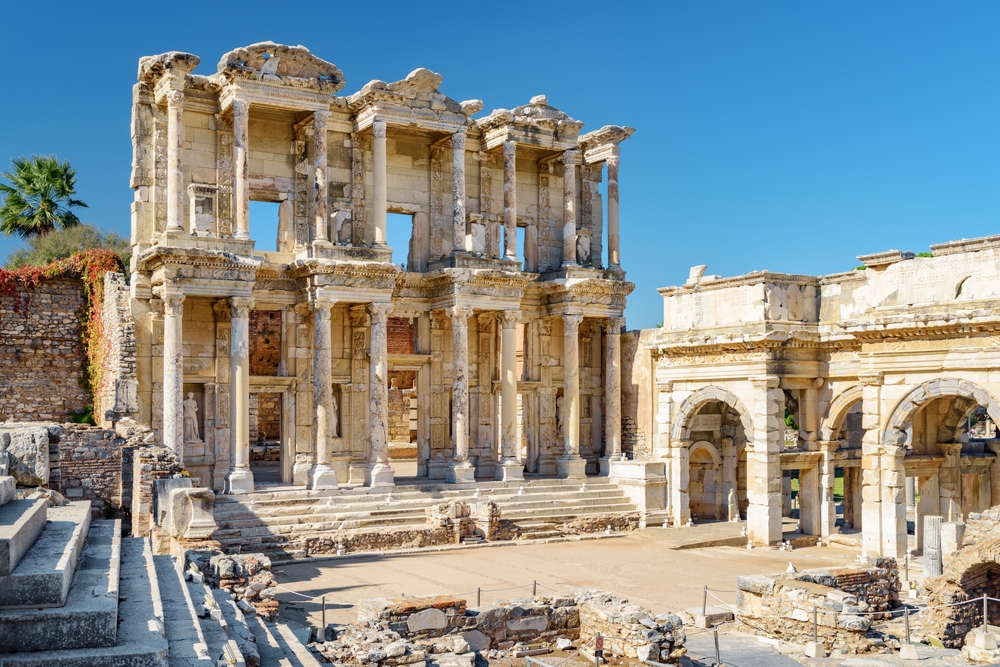
Ephesus, Turkey:
Ephesus, located in Turkey, is adorned with a magnificent mosaic of historical and cultural significance. This archaeological marvel is a trove of well-preserved Roman ruins in the scenic Aegean region. Stroll down marble-paved streets that once echoed with footsteps of philosophers, politicians, and commoners alike. The Library of Celsus, a stunning architectural masterpiece, is a testament to human ingenuity.
Explore the expansive amphitheater where grand performances once enthralled audiences. Ephesus, a UNESCO World Heritage Site, is a must-visit for history enthusiasts and wanderers alike.
Tourist attractions and things to do in Ephesus, Turkey:
- Library of Celsus: An ancient Roman building erected in honor of the Roman Senator Tiberius Julius Celsus Polemaeanus, the library is a stunning facade with intricate details and once held nearly 12,000 scrolls, making it one of the largest libraries of the ancient world.
- The Great Theatre: This grand theatre is one of the highlights of Ephesus, with a capacity of 25,000 spectators. It is steeped in history, having hosted classical plays, gladiator fights, and early Christian sermons by St. Paul.
- Temple of Artemis: Although only one column remains, this site was once home to one of the Seven Wonders of the Ancient World. It provides insight into the religious and cultural importance of the ancient city.
- Terrace Houses: These houses provide a fascinating look at the life of Ephesus’ wealthy residents, with mosaics and frescoes decorating the interiors of these well-preserved residences.
- Ephesus Archaeological Museum: Located in nearby Selçuk, the museum houses many important artifacts from Ephesus, including statues, architectural fragments, and coins, which provide context to the ruins and help visitors understand the city’s significance in ancient times.
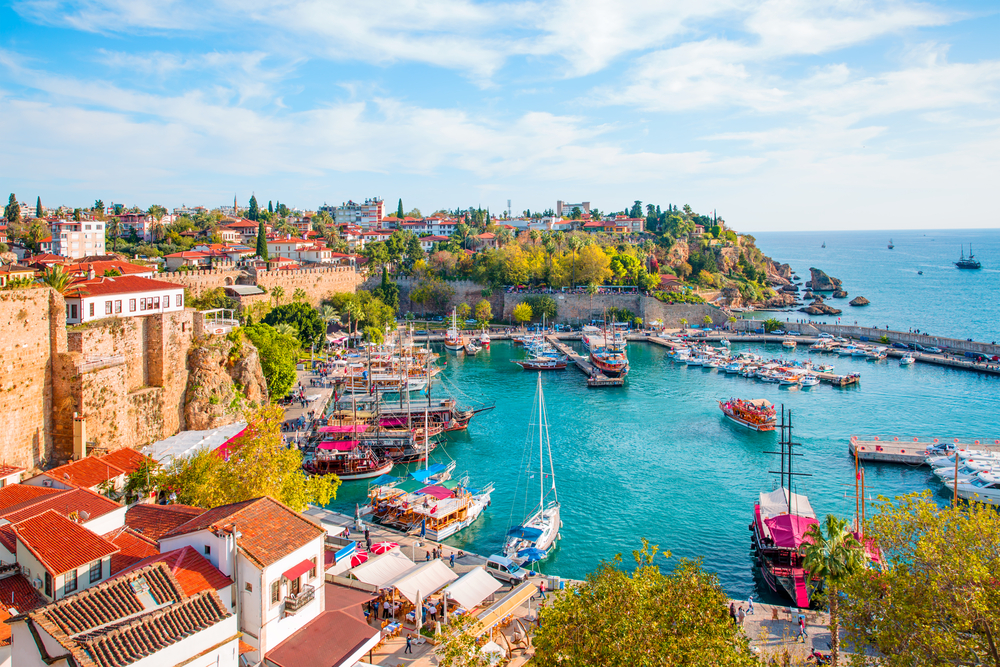
Antalya, Turkey:
A beautiful blend of history and nature lies along Antalya’s Mediterranean coast, Turkey. This beautiful coastal haven welcomes visitors with its pristine beaches, cerulean waters, and a gentle, year-round climate that soothes the soul. Within Antalya’s heart lies the Old Town, Kaleiçi, an intricate labyrinth of cobbled streets adorned with timeless Ottoman residences and iconic landmarks such as Hadrian’s Gate.
Venture further to discover the age-old secrets of Perge, an archaeological marvel, and the grandeur of Aspendos Theater, where echoes of ancient performances still linger. Nature enthusiasts can lose themselves in the cascade of Düden Waterfalls, which gracefully spill into the sea, offering sublime vistas. Antalya’s rich culture and delectable cuisine only deepen its irresistible charm.
Tourist attractions and things to do in Antalya, Turkey:
- Old Town (Kaleiçi): The historical center of Antalya, with its narrow winding streets lined with restored Ottoman-era houses, small boutique hotels, shops, and restaurants. The area retains much of its historical charm and is a delight to explore.
- Hadrian’s Gate (Üçkapılar): An ornate Roman triumphal arch built in honor of Emperor Hadrian, who visited Antalya in 130 AD. It’s beautifully preserved and serves as a grand entrance to the Old Town.
- Düden Waterfalls: These are a set of stunning waterfalls just outside the city. The Upper Düden Waterfalls are surrounded by a quiet park, while the Lower Düden Waterfalls plunge straight into the sea, best viewed from a boat.
- Antalya Museum (Antalya Arkeoloji Müzesi): One of Turkey’s largest museums offers an extensive collection of artifacts from the Mediterranean and Pamphylia regions, illuminating the area’s rich archaeological history.
- Konyaaltı and Lara Beaches: Antalya’s main beaches are vast stretches of pebble and sand, offering crystal-clear waters, beachfront cafes, and recreational activities, with the stunning backdrop of the Taurus Mountains.
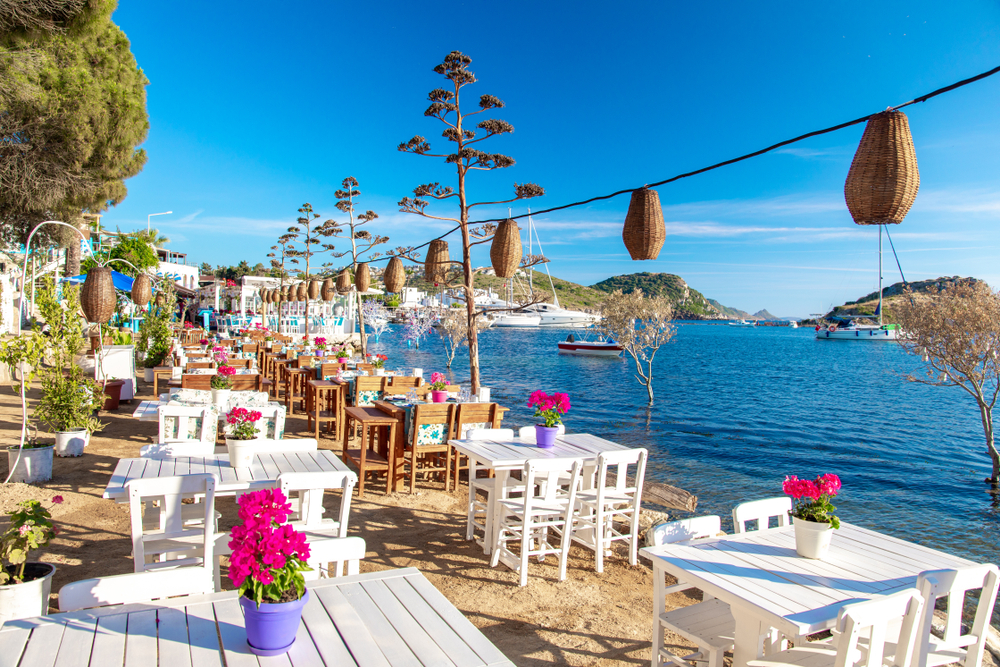
Bodrum, Turkey:
Bodrum, Turkey, located by the calm Aegean Sea, welcomes you with its lasting beauty. The azure waters kiss the rugged shores while white-washed buildings dot the landscape. The ancient joy of Bodrum Castle stands tall, a sentinel of history against the modern world.
Stroll through the bustling bazaars, where fragrant spices mingle with the melodies of street musicians. Savory Turkish cuisine tempts the senses, a feast of kebabs and baklava. Bodrum’s vibrant nightlife awakens as the sun dips below the horizon, offering a taste of the city’s spirited energy.
Tourist attractions and things to do in Bodrum, Turkey:
- Bodrum Castle (Castle of St. Peter): This 15th-century fortress now houses the Museum of Underwater Archaeology and offers stunning views of the harbor and the Aegean Sea. The castle’s towers, ramparts, and gardens are well-preserved and provide insight into medieval architecture.
- Mausoleum at Halicarnassus: Although only ruins remain, this site was once home to one of the Seven Wonders of the Ancient World, a massive tomb built for Mausolus, a satrap of the Persian Empire.
- Bodrum Amphitheater: This ancient Greek theater dates back to the 4th century BC and still hosts events and concerts today. It seats about 13,000 people and offers excellent acoustics and views of Bodrum and the sea.
- Bodrum Marina & Yacht Club: A stroll along the marina offers views of luxurious yachts and traditional gulets. The yacht club is a great spot to relax and watch the sunset while enjoying a meal or a drink.
- Bodrum Beaches: Bodrum Peninsula boasts a number of stunning beaches such as Bitez Beach and Gumbet Beach, offering crystal clear waters, a variety of water sports, and lively beachfront bars and cafes.
Ready to Explore Top Destinations in Asia?

Göreme, Turkey:
In Turkey’s southwestern corner, Gerome is a remote village wrapped in history that boasts surreal landscapes of honey-hued rock formations, caves, and fairy chimneys. Wander through its labyrinthine streets, where cobblestones echo ancient footsteps. As the sun dips behind the unique landscapes, Gerome transforms into a dreamscape, igniting the rocks with hues of red and gold.
The Goreme Open-Air Museum is a highlight, revealing Byzantine-era cave churches adorned with remarkable frescoes. Savor traditional Turkish cuisine in cozy cafes and experience hot air balloon rides that grant breathtaking views of this captivating land. Gerome is a masterpiece of intertwined nature and human history, where time slows and the spirit soars.
Tourist attractions and things to do in Goreme, Turkey:
- Göreme Open-Air Museum: This is one of the most popular attractions in Cappadocia, featuring a complex of medieval painted cave churches carved out by Orthodox monks.
- Hot Air Balloon Rides: Göreme is famous for its hot air balloon experiences, where visitors can float above the unique fairy chimneys, valleys, and rock formations at sunrise.
- Fairy Chimneys: The town is surrounded by these natural rock formations, and you can walk through valleys like Love Valley and Rose Valley to see them up close.
- Uchisar Castle: Just a short distance from Göreme, this natural rock castle offers a high vantage point with panoramic views of the entire region.
- Cave Hotels: Göreme is known for its cave hotels, where visitors can stay in rooms carved out of the soft volcanic rock, combining modern comforts with a taste of troglodyte living.
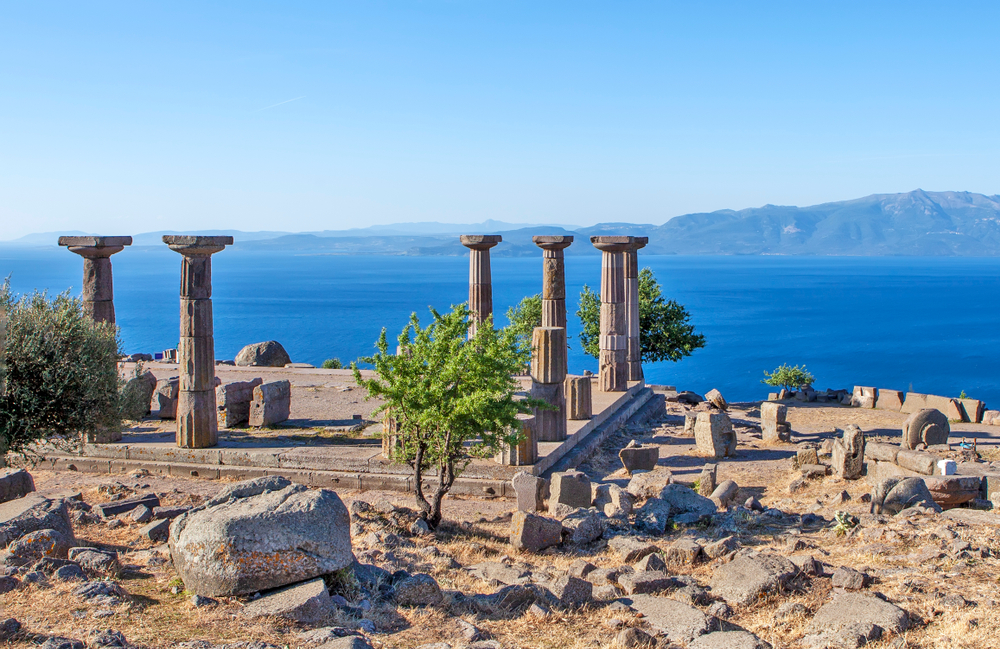
Troy, Turkey:
Troy, Turkey, is a place steeped in ancient history. This legendary city, nestled in the picturesque landscape of Anatolia, evokes the epic tales of Homer’s Iliad. Wander through its ruins, and you’ll feel the echoes of the Trojan War, where heroes clashed and the wooden horse’s ruse unfolded.
Stand atop the walls of Troy, and the Aegean Sea’s expanse spreads before you, a reminder of the city’s strategic importance in antiquity. The archaeological treasures here offer a glimpse into the lives of those who once walked these streets. Troy in Turkey, full of history, calls for explorers to dive into its long-lasting story.
Tourist attractions and things to do in Troy, Turkey:
- Ancient Ruins of Troy: Explore the multi-layered archaeological site where, according to legend, the Trojan War took place. Excavations have revealed nine main layers of cities, superimposed over each other, spanning several millennia.
- Wooden Trojan Horse: While in Troy, don’t miss the iconic wooden horse, reminiscent of the mythical subterfuge from Homer’s epic, “The Iliad.” Although not ancient, this large wooden structure symbolizes the city’s legendary past.
- Troy Museum: Opened recently, this modern museum showcases artifacts from Troy and the Troad region, offering context to the ancient city’s history and legend through its extensive archaeological findings.
- Archaeological Site Tours: Guided tours can provide deeper insight into the complex history of Troy, the significance of the different settlement layers, and how the city fits into the broader context of ancient history.
- Replica of the Shield of Achilles: An artistic representation based on descriptions from Homer’s “Iliad,” this shield adds a touch of tangible mythology to the visit and is a favorite photo opportunity for visitors.
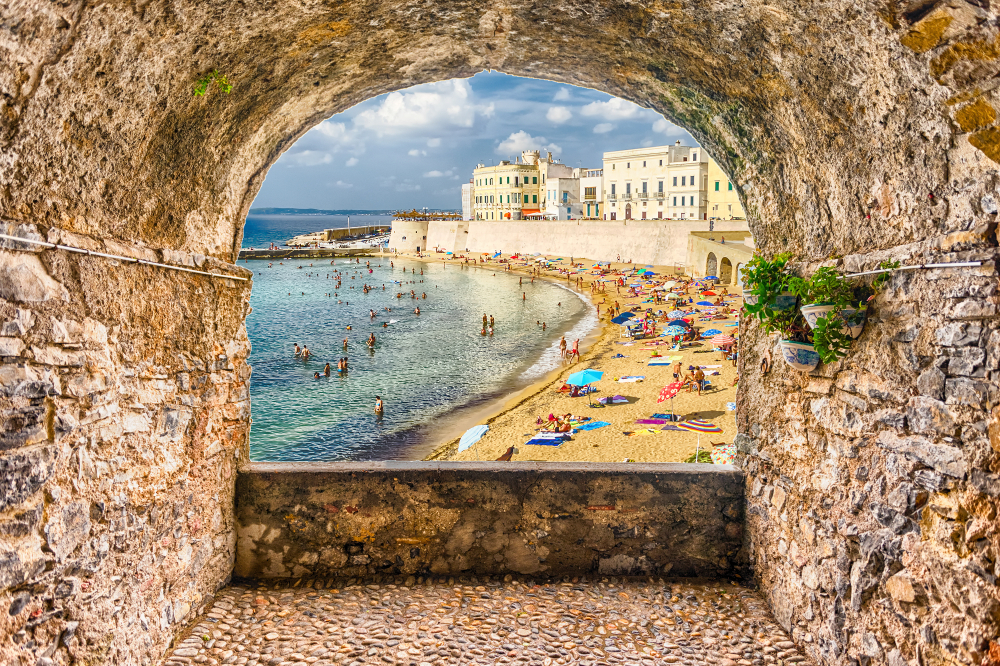
Gallipoli, Turkey:
Gallipoli, Turkey, is a name that evokes memories of a distant and brutal past. This rugged peninsula, jutting defiantly into the Aegean Sea, has witnessed the clash of empires and the sacrifice of countless lives. Gallipoli is where history’s scars etch themselves into the very earth, where the ghosts of soldiers from Australia, New Zealand, and the Ottoman Empire still seem to linger in the salt-tinged breeze.
As you stand on those hallowed shores, you will feel the weight of the past, the solemnity of a battleground turned memorial. Gallipoli is a place where the futility of war is eternally etched in stone, a haunting reminder of the human cost of conflict.
Tourist attractions and things to do in Gallipoli, Turkey:
- Gallipoli Peninsula Historical National Park: This park is dedicated to the memory of the soldiers who fought and died in the Gallipoli Campaign during World War I. Visitors can tour the battlefields, which are now a serene landscape of monuments, cemeteries, and memorials.
- ANZAC Cove: This small cove is where the Australian and New Zealand Army Corps (ANZAC) landed on April 25, 1915. It is the site of the annual ANZAC Day dawn services, remembering the soldiers who lost their lives on Turkish soil.
- Lone Pine Australian Memorial: The main Australian memorial site on the Gallipoli Peninsula, it commemorates Australian soldiers who fought and died in the Battle of Lone Pine in August 1915.
- Chunuk Bair New Zealand Memorial: This memorial stands on one of the highest points captured by the ANZAC forces during the campaign and is dedicated to the New Zealanders who served and lost their lives on the Gallipoli Peninsula.
- Çanakkale Martyrs’ Memorial: This large and impressive monument is dedicated to the Turkish soldiers who defended the peninsula. It stands as a testament to Turkish bravery and the intense battles that took place, offering views of the surrounding battlefields and the Dardanelles.
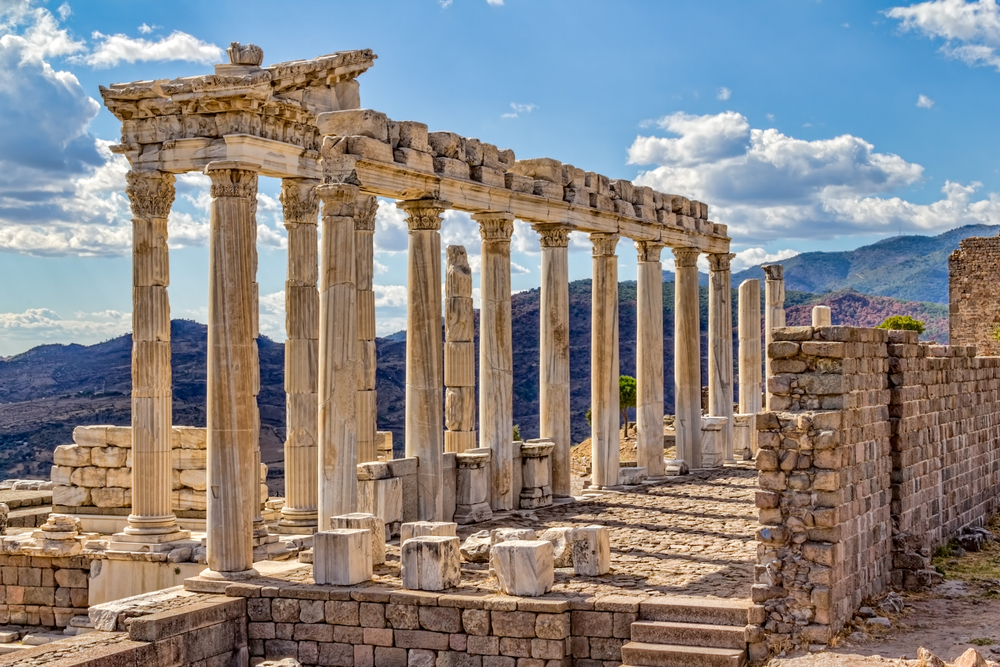
Pergamon, Turkey:
In the rough terrain of Anatolia, where history echoes in old stones, Pergamon, Turkey, remains proof of time, calling for explorers to uncover its secrets. As you roam its sprawling ruins, you will feel transported to an era when this city was a bastion of knowledge and influence.
The Great Altar, perched on a steep hillside, exuded the grandeur of its Hellenistic past, while the remarkably preserved theater recalled the captivating performances that once enthralled its inhabitants. Pergamon’s library, second only to Alexandria’s, hinted at the intellectual fervor that once thrived here. Amid these remnants, Pergamon’s enduring charm continues to captivate those searching for a glimpse into the annals of human history.
Tourist attractions and things to do in Pergamom, Turkey:
- Acropolis: The Acropolis of ancient Pergamon sits atop a hill and includes a number of impressive structures such as the Altar of Zeus, the Temple of Trajan, and the world’s steepest ancient amphitheater.
- Pergamon Altar: Renowned for its richly decorated frieze, this massive structure is considered a masterpiece of Hellenistic art. Although the altar itself is in the Pergamon Museum in Berlin, the site offers a glimpse into its grandeur.
- Asclepion: This ancient medical center dedicated to Asclepius, the god of medicine, was an early type of sanatorium and one of the most famous healing centers of the ancient world.
- Red Basilica (Kızıl Avlu): Originally a temple dedicated to the Egyptian gods and later converted into a basilica, its red brick walls give the structure its distinctive name and it is considered one of the Seven Churches of Revelation.
- Archaeological Museum of Bergama: This museum houses many artifacts from the Pergamon acropolis and other ancient sites in the area. The displays include ceramics, coins, and sculptures that tell the story of the city’s past.
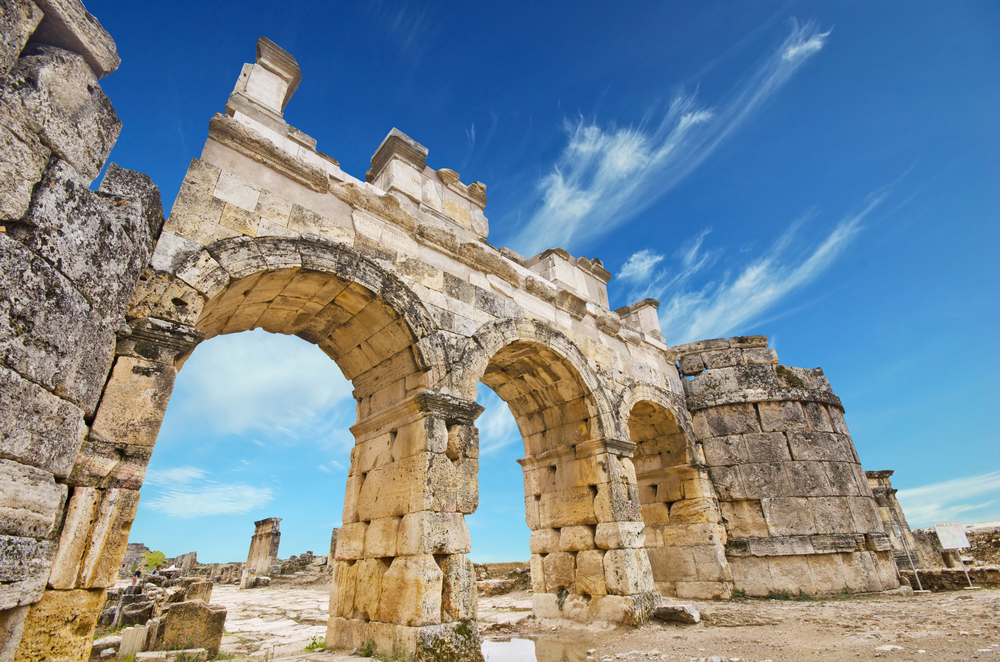
Hierapolis, Turkey:
In the heart of Turkey, the ancient city of Hierapolis emerges like a ghostly apparition from the mist of time. Its name echoes through history, a testament to the enduring allure of human civilization. As you wander its cobblestone streets, you will be transported back in time, surrounded by the remnants of a once-thriving Roman city.
The grandeur of its well-preserved theater, the mesmerizing travertine terraces of Pamukkale, and the sacred pools of Cleopatra’s Bath all whispered tales of a bygone era. Hierapolis is a place where past and present converge, where history comes alive beneath the Turkish sun, a testament to the timeless allure of the ancient world.
Tourist attractions and things to do in Hierapolis, Turkey:
- Pamukkale Thermal Pools: Adjacent to the ancient city of Hierapolis, these natural hot springs with terraced, white limestone pools are formed by calcite-rich waters, offering a picturesque and unique bathing experience.
- Hierapolis Archaeological Site: The extensive ruins of Hierapolis provide insight into the city’s history as a spa and sacred site, including a well-preserved theater, a vast necropolis, and various temples.
- Cleopatra’s Pool: Also known as the Antique Pool, this geothermal spring is said to have been a gift from Marc Antony to Cleopatra. Today, visitors can swim among ancient ruins which lie at the bottom of the pool.
- Hierapolis Museum: Located in the former Roman baths, the museum houses artifacts discovered during excavations of Hierapolis. Its collections include sarcophagi, statues, and inscriptions, as well as small everyday items that give a glimpse into ancient life.
- Plutonium: An ancient religious site dedicated to Pluto, the god of the underworld. It was believed to be the entrance to Hell because of the toxic gases that emerge from the cave, making it a significant ritualistic site for ancient people.
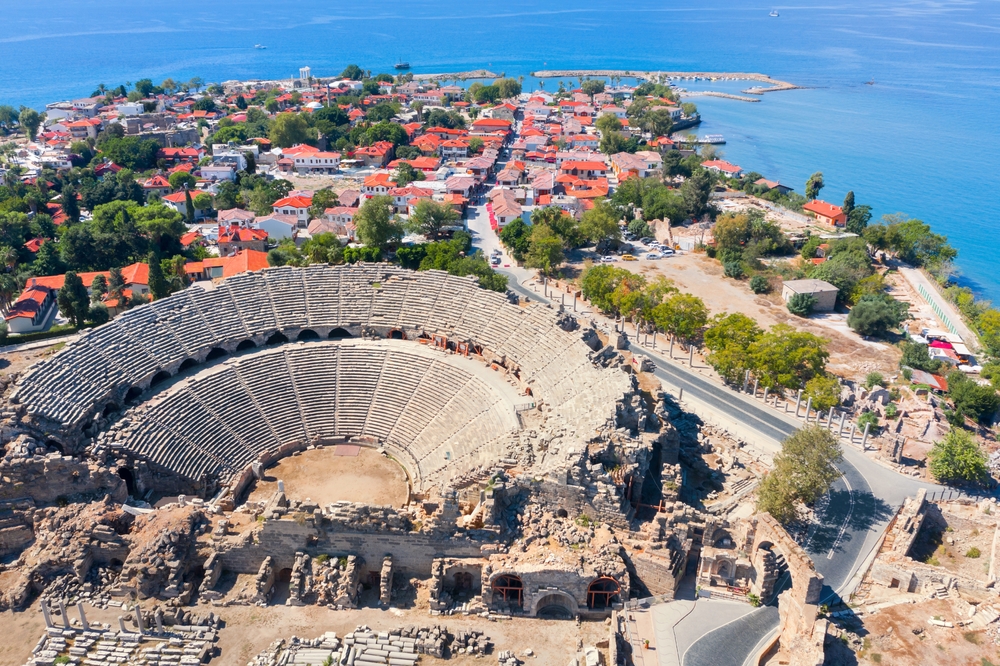
Side, Turkey:
Side, Turkey is where time seems to linger, suspended in the warm embrace of the Mediterranean sun. Like weathered storytellers, its ancient ruins whisper tales of empires long gone. The bustling bazaar, a sensory overload of colors, scents, and voices, transports you to another era.
Stroll along the sun-kissed shoreline, and you’ll find a patchwork of beachfront cafes where the aroma of freshly grilled seafood mingles with the salty breeze. The warmth of the locals matches the climate, inviting travelers to savor the simple pleasures of life.
Tourist attractions and things to do in Side, Turkey:
- Ancient Theatre: An impressively preserved Roman amphitheater that once seated up to 15,000 spectators. It’s a testament to Side’s ancient importance and is still used for performances today.
- Temple of Apollo: Situated at the end of Side’s peninsula, the temple ruins are particularly stunning at sunset. The standing columns set against the backdrop of the sea make for a romantic and picturesque scene.
- Side Museum: Housed in the restored remains of the ancient Roman baths, the museum displays a range of artifacts from the region, including Roman statues, sarcophagi, and other archaeological finds that offer insight into the city’s past.
- Agora: The ancient market place of Side is a sprawling area of ruins where merchants once sold their goods. It provides a sense of the daily life in ancient Side, complete with remnants of shops and public spaces.
- Aspendos Bridge: This Roman bridge, which spans the Koprucay River just outside Side, is an impressive example of Roman engineering. Though it was modified in the 13th century, it still retains its ancient character.
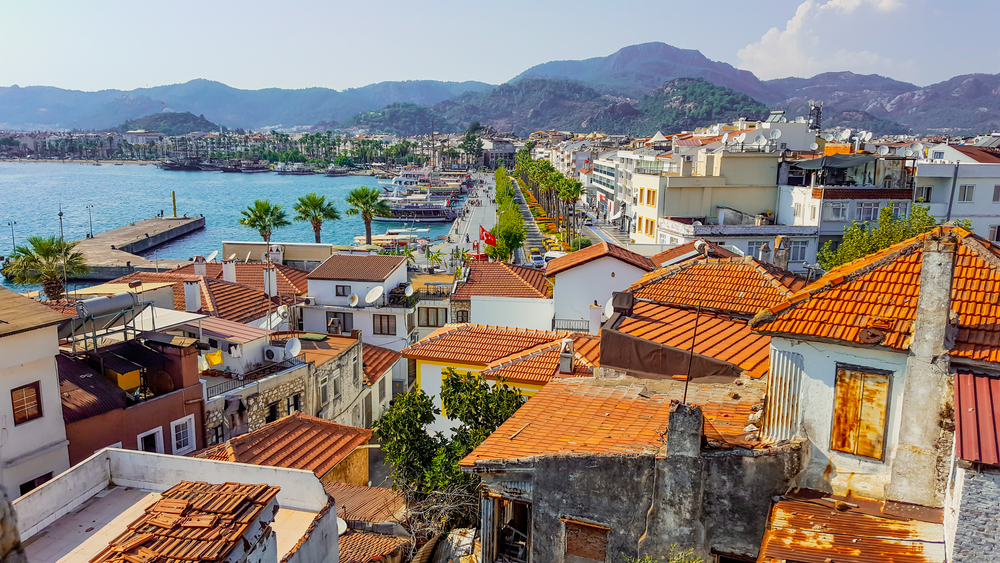
Marmaris, Turkey:
Marmaris, Turkey, nestled along the southwestern coast, blends Mediterranean charm and lively energy. As you wander through its labyrinthine streets, you will be charmed by the aroma of freshly grilled kebabs wafting from the bustling bazaars. The azure waters of the Aegean Sea whisper tales of ancient mariners, and the marina glistens with luxury yachts, a testament to modern indulgence.
Marmaris retains an authenticity that harks back to its fishing village roots. The locals, with their warm hospitality and genuine smiles, welcomed me into their world, making Marmaris a memorable stop on my journey through the tapestry of Turkey’s diverse landscapes and cultures.
Tourist attractions and things to do in Marmaris, Turkey:
- Marmaris Castle and Museum: The castle dates back to the Ionian period, but it was rebuilt by the Ottomans in 1522. It now houses a museum with archaeological and historical exhibits, offering great views of the city and bay.
- Marmaris Marina: A bustling area filled with yachts and boats, the marina is lined with cafes, restaurants, and shops, making it a perfect place for a leisurely stroll or a meal with a view of the picturesque waterfront.
- Icmeler Beach: Just 8 kilometers from Marmaris, this beach is known for its clear blue waters and beautiful backdrop of pine-clad hills, offering a quieter alternative to the busier beaches in Marmaris itself.
- Dalyan River Cruise: A boat trip to the nearby town of Dalyan includes sights such as the ancient city of Kaunos, the rock tombs carved into the cliffs, and the famous Iztuzu Beach, known for its nesting sea turtles.
- Marmaris National Park: This park is a haven for nature lovers, with opportunities for hiking, picnicking, and observing local wildlife. The scenery includes stunning mountain views, pine forests, and crystal-clear streams.
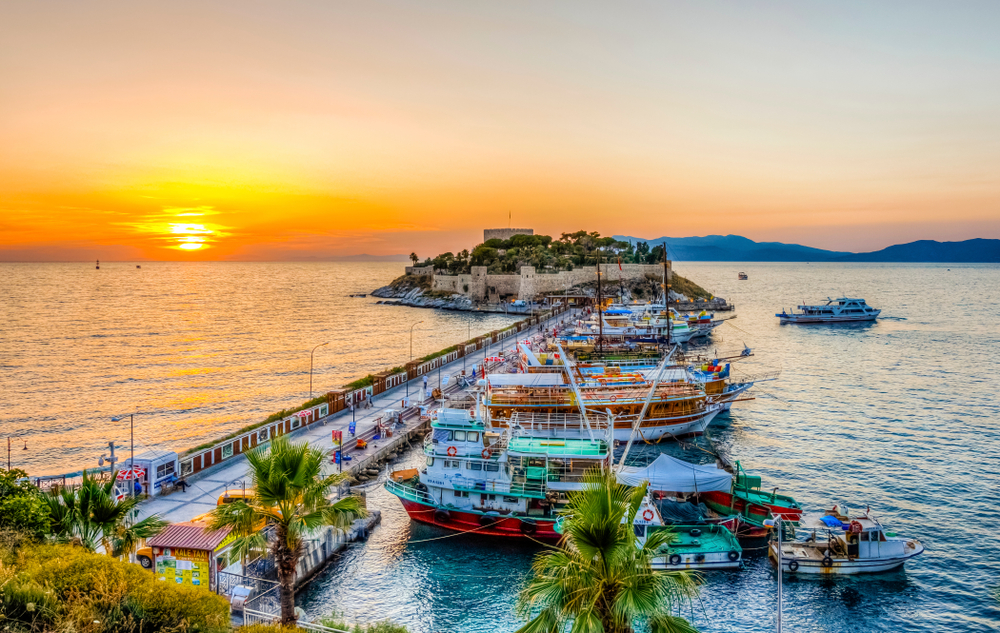
Kusadasi, Turkey:
With its sun-soaked shores and bustling bazaars, Kusadasi, Turkey, is a coastal gem on the Aegean coast. As soon as you set foot in its labyrinthine streets, you feel transported to where the stones of historic sites like Ephesus echo the whispers of centuries past, telling stories of a bygone era.
Kusadasi is a vibrant town where the scent of grilled kebabs mingles with the sea breeze, and the rich colors of textiles dance in the market stalls.
Tourist attractions and things to do in Kusadasi, Turkey:
- Ephesus Ruins: While not in Kusadasi itself, the ancient city of Ephesus is a short drive away and is one of the most significant and well-preserved Greco-Roman sites in the world, featuring the Library of Celsus, the Great Theatre, and the Temple of Artemis, one of the Seven Wonders of the Ancient World.
- Kusadasi Castle: Located on Pigeon Island, the castle dates back to Byzantine times and offers a historical landmark with a great view of the town and the surrounding Aegean Sea.
- Ladies Beach (Kadinlar Denizi): This popular beach is known for its fine sand, clear waters, and vibrant promenade lined with cafes, restaurants, and shops. It’s a perfect spot for sunbathing, swimming, and enjoying water sports.
- Dilek Peninsula-Büyük Menderes Delta National Park: This national park, a short drive from Kusadasi, offers beautiful beaches, hiking trails, and the chance to observe diverse flora and fauna, including wild boar and the Anatolian leopard.
- Adaland: One of the largest water parks in Europe, Adaland offers a variety of water slides, a wave pool, a lazy river, and a dedicated kid’s area, making it an ideal family outing.
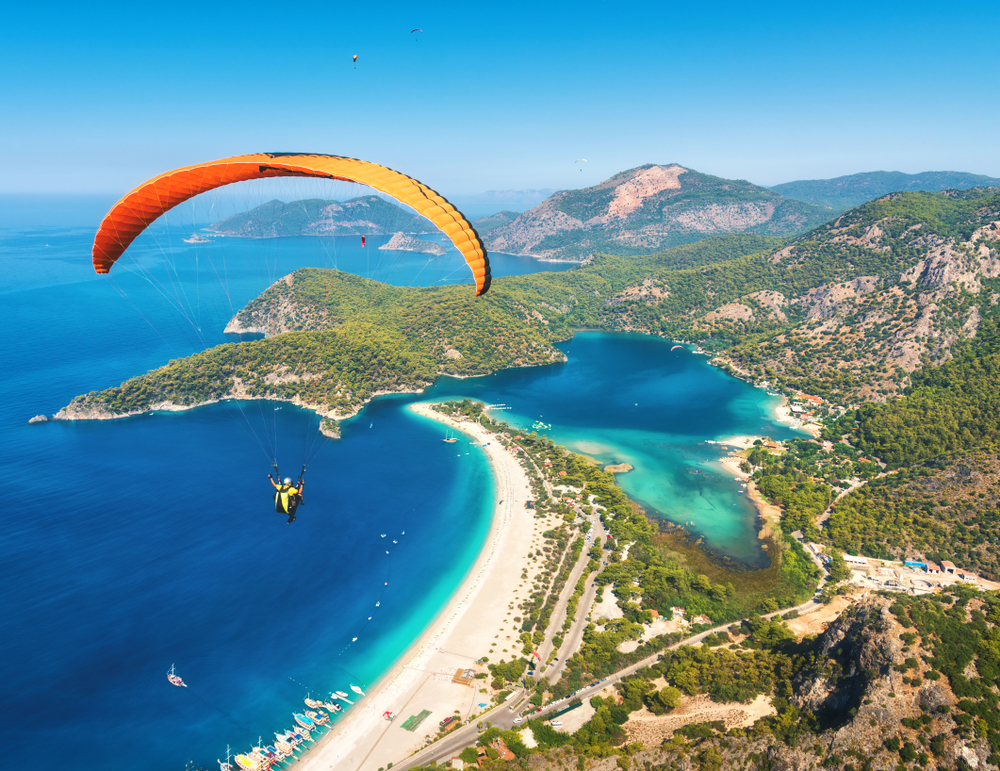
Oludeniz, Turkey:
On the southwestern coast, Oludeniz is a picturesque destination that boasts the renowned Blue Lagoon, where azure waters gently caress a flawless beach. The Babadag Mountains provide exhilarating paragliding opportunities, allowing adventurers to soar above this coastal gem.
Strolling through the charming village, one encounters warm hospitality and indulges in delectable Turkish cuisine. Oludeniz embodies a perfect blend of natural beauty and cultural richness, offering an unforgettable experience for travelers seeking tranquility and adventure.
Tourist attractions and things to do in Oludeniz, Turkey:
- Blue Lagoon (Oludeniz Beach): Famous for its turquoise waters and calm lagoon, the Blue Lagoon is a natural beauty and one of Turkey’s most photographed beaches. It’s a perfect spot for swimming and paragliding due to the stable weather conditions.
- Paragliding from Babadag Mountain: Oludeniz is one of the world’s top paragliding destinations, offering breathtaking views of the Blue Lagoon and the surrounding coastline from the air.
- Butterfly Valley: Accessible by boat from Oludeniz, this nature reserve is home to diverse species of butterflies and a beautiful waterfall, nestled within a canyon with a secluded beach.
- The Lycian Way: Oludeniz is a starting point for this famous long-distance footpath running along the coast of ancient Lycia. Hikers can enjoy stunning coastal scenery, explore ruins, and visit remote beaches.
- Kayakoy Ghost Village: This abandoned Greek village, also known as Karmylassos, is a short distance from Oludeniz and offers a hauntingly beautiful exploration experience, with over 500 deserted houses and churches to wander through.
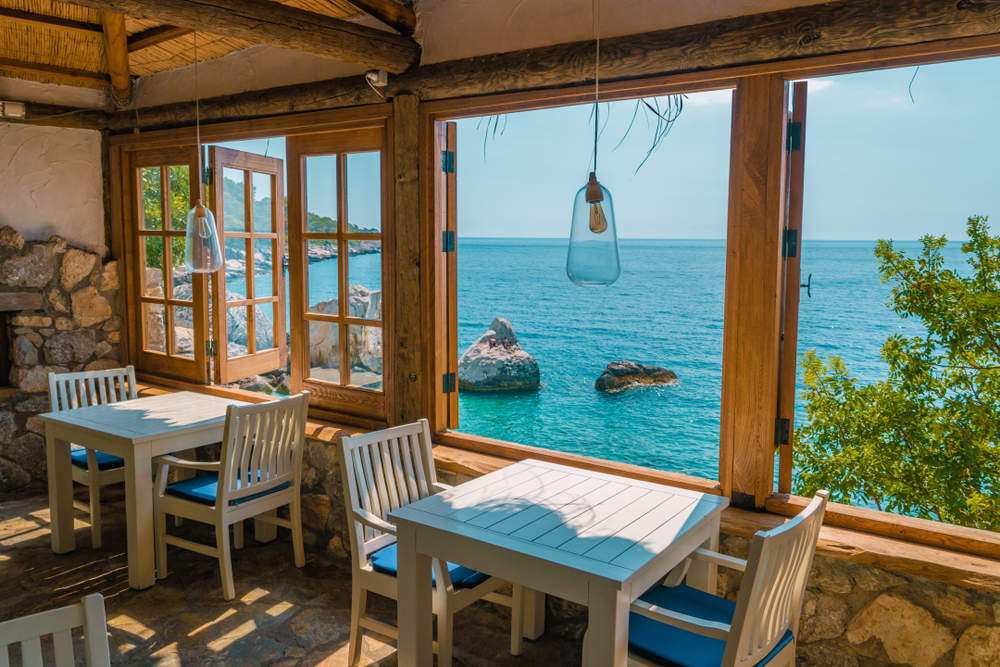
Fethiye, Turkey:
Fethiye, surrounded by the Taurus Mountains, shows the rich history of Turkey. Lycian rock tombs stand sentinel, whispering tales of bygone eras while bustling bazaars overflow with the vibrant energy of modern-day commerce.
As dhow boats bob gently in the harbor, the call of minarets meshes with the scent of freshly grilled kebabs, drawing travelers into the intimate dance of Anatolian rhythms.
Tourist attractions and things to do in Fethiye, Turkey:
- Saklikent Gorge: A stunning natural wonder, this is one of the deepest canyons in the world. Visitors can walk on suspended wooden platforms, wade through refreshing mountain waters, and enjoy the magnificent natural scenery.
- Oludeniz Beach and Blue Lagoon: Although it’s closer to Oludeniz, Fethiye is often the main hub from which many tourists visit this renowned beach with its tranquil, azure waters, and take part in paragliding activities from the surrounding mountains.
- Tomb of Amyntas: An impressive Lycian rock tomb carved into a cliff face overlooking Fethiye, it dates back to the 4th century BC and offers a glimpse into the area’s ancient past.
- Fethiye Museum: This museum houses a collection of artifacts from the Lycian and Roman periods, providing context to the rich history of the region with exhibits of tombstones, coins, and other ancient relics.
- Calis Beach: A picturesque beach located a short distance from Fethiye, known for its beautiful sunsets, sea turtle nesting grounds, and a promenade lined with restaurants and bars.
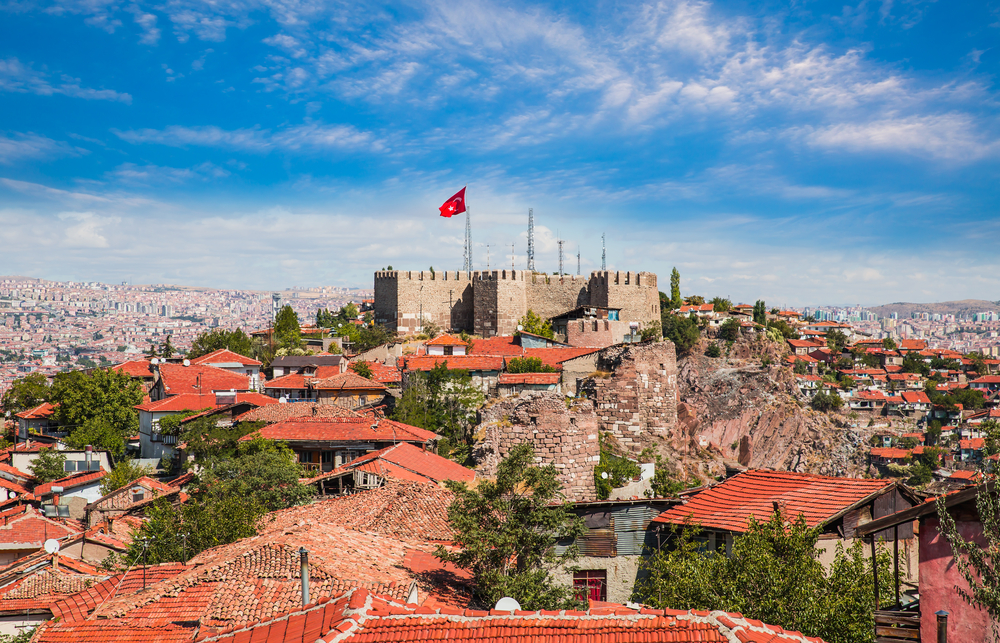
Ankara, Turkey:
Ankara, Turkey’s capital, stands at Anatolia’s heart, blending ancient history with modernity. Known initially as Ancyra in antiquity, the city has witnessed the rise and fall of many civilizations, from the Phrygians to the Romans, each leaving indelible marks on its cultural fabric.
Today, amidst its bustling streets, one can find remnants of its storied past, such as the Temple of Augustus and the Roman Theatre. As the epicenter of Turkish politics and administration, Ankara also boasts notable modern architecture, like the grand Atatürk Mausoleum, paying homage to Mustafa Kemal Atatürk, the founder of the modern Turkish Republic.
Tourist attractions and things to do in Ankara, Turkey:
- Anıtkabir: The mausoleum of Mustafa Kemal Atatürk, the founder of the Republic of Turkey, Anıtkabir is not only a site of immense national significance but also an impressive architectural marvel with its vast courtyards and halls.
- Museum of Anatolian Civilizations: Housing one of the richest collections of ancient artifacts in the country, this museum provides a deep dive into Turkey’s history, from the Paleolithic era to the classical period.
- Ankara Castle: This ancient fortress offers panoramic views of the city. The area around the castle is filled with old houses, narrow streets, and artisan shops giving a glimpse into the city’s past.
- Kocatepe Mosque: As the largest mosque in Ankara, it’s an iconic part of the city’s skyline. The mosque’s architecture is a blend of classical Ottoman with modern styles and can accommodate 24,000 worshippers.
- Atakule: This tower is a landmark and a symbol of the capital, offering expansive views from its observation deck and revolving restaurant, giving visitors a 360-degree view of Ankara.
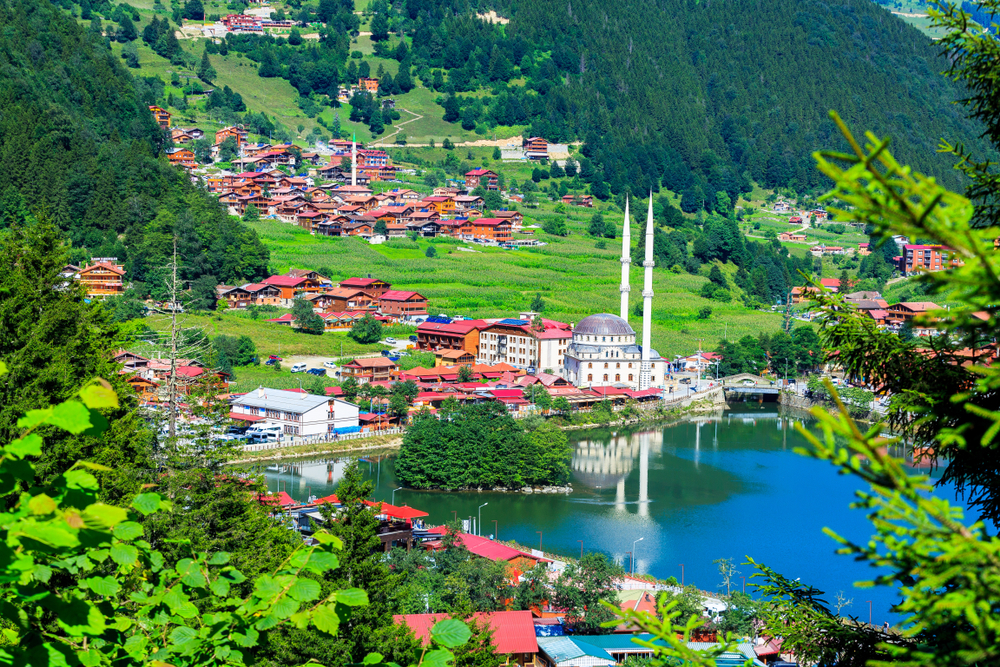
Trabzon, Turkey:
Trabzon, nestled along the northeastern coastline of Turkey, is a historic port city on the Black Sea. Steeped in millennia of history, it was once the hub of the ancient Silk Road, serving as a melting pot for numerous civilizations.
The city is renowned for the Sumela Monastery, an old Orthodox Christian structure carved into the cliffs of the Maçka district, offering breathtaking views of the surrounding forested landscape.
Trabzon’s Hagia Sophia, a beautiful example of Byzantine architecture, is a testament to the city’s diverse past.
Tourist attractions and things to do in Trabzon, Turkey:
- Sumela Monastery: Perched on the cliffs of the Macka Valley, this Greek Orthodox monastery is a marvel of ancient engineering and artistry, with stunning frescoes and a dramatic backdrop of forested mountains.
- Uzungöl: Also known as “Long Lake,” Uzungöl is a serene lake surrounded by mountains, offering picturesque landscapes and the opportunity for nature walks, picnics, and relaxation in a peaceful setting.
- Atatürk Köşkü: A historic mansion set amid lush gardens that once served as a residence for Mustafa Kemal Atatürk, the founder of modern Turkey. It’s now a museum that reflects early Republican era furnishings and architecture.
- Trabzon Hagia Sophia: A beautiful example of Byzantine architecture, this 13th-century church (not to be confused with its namesake in Istanbul) features impressive frescoes and has served various roles, including a mosque and now as a museum.
- Boztepe: A hill offering a panoramic vista of the city and the Black Sea. It’s a popular spot, especially at sunset, and can be reached by road or cable car. Visitors often come here to enjoy a tea or coffee with a view.
Ready to Explore Top Destinations in North America?
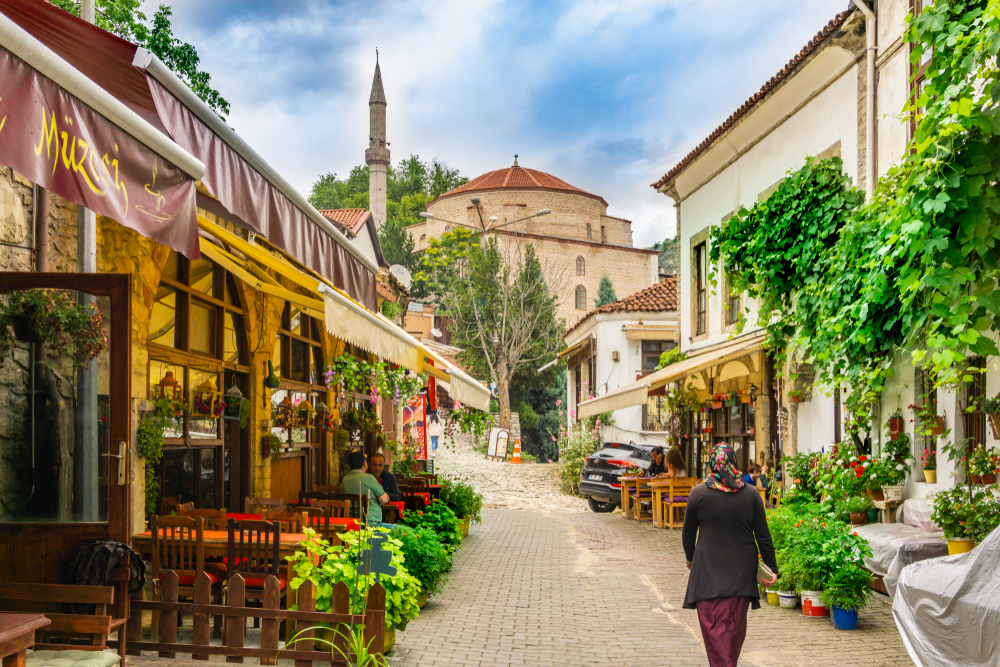
Safranbolu, Turkey:
Safranbolu, a UNESCO World Heritage Site in Turkey, is rich in history and architectural prowess. This town, nestled in the Black Sea region, showcases a pristine preservation of Ottoman-era houses, meandering cobbled streets, and vibrant bazaars.
The region cultivates the precious saffron spice, and many local delicacies use it, giving the town its name. Walking through Safranbolu is akin to stepping back in time, where every corner tells a story of ancient traditions, artisanal crafts, and a way of life that has withstood the test of time.
Tourist attractions and things to do in Safranbolu, Turkey:
- Old Town (Çarşı): The heart of Safranbolu is its old town, known for its well-preserved Ottoman-era houses and winding cobblestone streets, which have earned it a place on the UNESCO World Heritage list.
- Cinci Hanı: This historic caravanserai, now operating as a hotel, is a striking example of Ottoman architecture. Visitors can explore the rooms and enjoy the ambiance of its courtyard.
- Kaymakamlar Museum House: Reflecting the typical Ottoman civilian architecture, this restored 19th-century house serves as a museum, showcasing how a wealthy Safranbolu family lived during that era.
- Safranbolu City History Museum: Providing insights into the town’s past, the museum exhibits artifacts and displays related to the daily life, culture, and the history of Safranbolu and its famous saffron trade.
- Hidirlik Hill: Offering a panoramic view of the town and its traditional Ottoman houses, Hidirlik Hill is the perfect spot to watch the sunset and take in the picturesque landscape of Safranbolu.
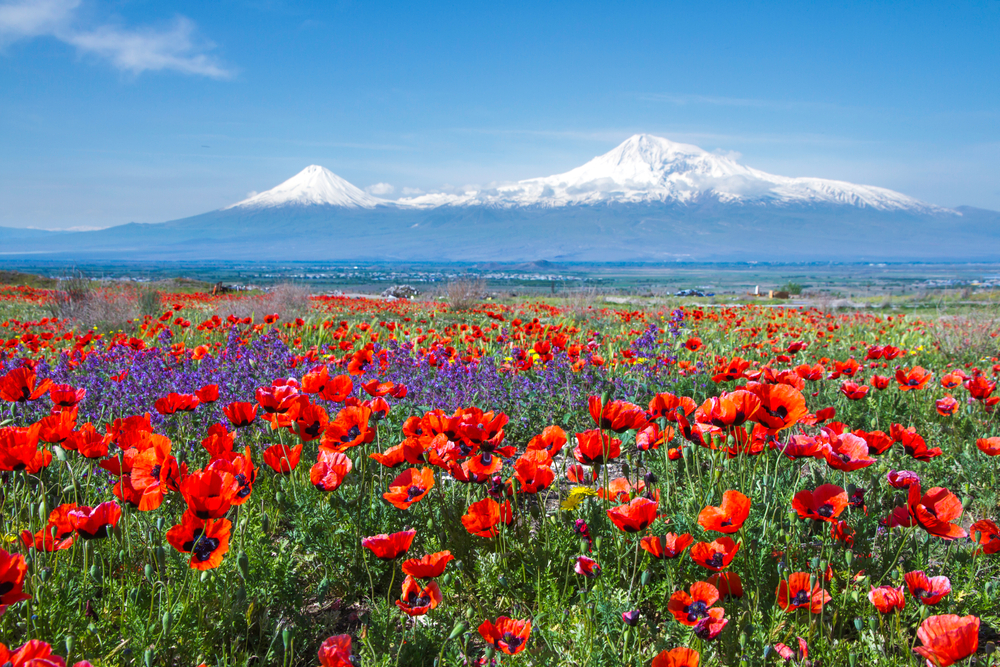
Mount Ararat, Turkey:
Mount Ararat is Turkey’s highest peak and holds significant cultural, historical, and religious importance. Located in the eastern part of the country, near the border with Armenia, this dormant compound volcano consists of two prominent volcanic cones: Greater Ararat, the highest peak at about 5,137 meters (16,854 feet), and Lesser Ararat, at 3,896 meters (12,782 feet).
Its silhouette is symbolic not just for Turkey but also for Armenia, where it plays a significant role in national symbolism, despite the peak lying just across the border in Turkish territory. With its snow-capped summit, the mountain offers a majestic view and is a popular subject for photographers and artists alike
Tourist attractions and things to do in Mount Ararat, Turkey:
- Summit Treks: Mount Ararat is Turkey’s highest peak, and for those who are adventurous, trekking to the summit can be a thrilling challenge. The ascent is usually done over a few days with a guide and proper permits.
- Ahora Gorge: An impressive canyon on the mountain, known for its historical significance and beautiful views. It’s also the site of a number of ruins, including a monastery complex.
- Ishak Pasha Palace: Although not on Mount Ararat itself, this palace is in the vicinity and worth a visit. It’s a semi-ruined palace and administrative complex that showcases a mix of Ottoman, Persian, and Armenian architectural styles.
- Meteor Crater: Near the mountain, there is a site believed to be a meteor crater, which is an interesting geological feature for those interested in natural history.
- Viewpoints: For those not wishing to climb, there are many viewpoints around the mountain that offer spectacular vistas of Ararat’s snow-capped peak, which is particularly stunning at sunrise or sunset.
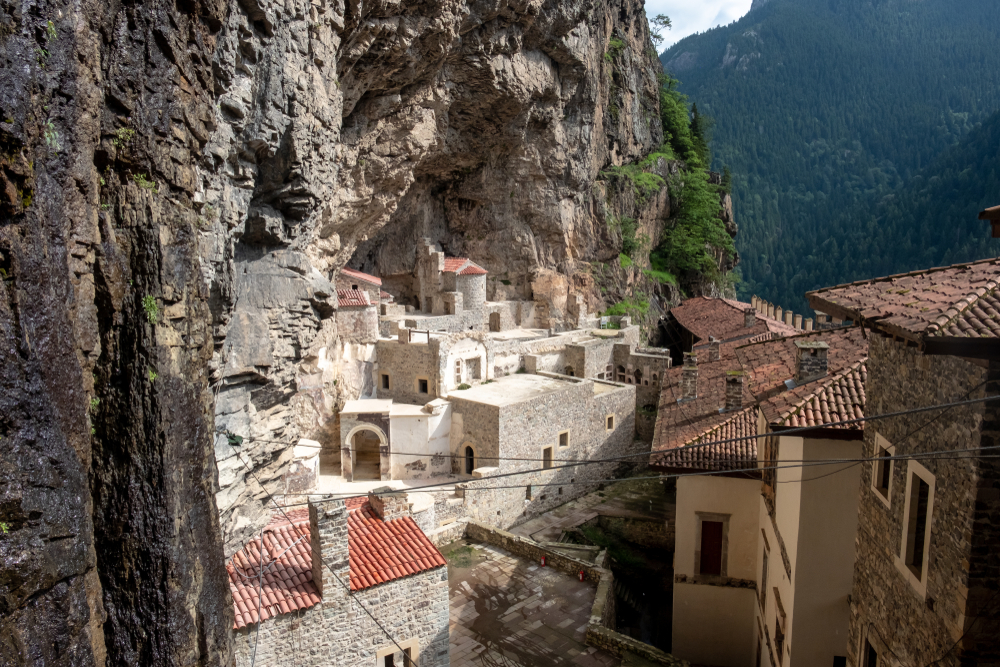
Sumela Monastery, Turkey:
The Sumela Monastery, located on the cliffs of Mela Mountain in Turkey’s Trabzon Province, is a historic Greek Orthodox structure dating back to the 4th century, with most of its present architecture from the 13th century. Renowned for its breathtaking vistas, detailed frescoes, and distinct architecture, the monastery boasts a chapel and residential areas.
While the internal frescoes showcase biblical narratives, they’ve experienced wear. Historically a pilgrimage destination for Orthodox Christians, Sumela was deserted in 1923 because of population shifts between Greece and Turkey. Now, after refurbishments, it stands as a favored tourist spot, celebrated for its rich history and picturesque allure.
Tourist attractions and things to do in Sumela Monastery, Turkey:
- Cliffside Architecture: The monastery is a marvel of ancient engineering, built into the side of a steep cliff face in the Pontic Mountains, offering a glimpse into the monastic life and the lengths taken to protect these places of worship.
- Frescoes: Inside the rock-hewn chapel, visitors can admire well-preserved frescoes depicting biblical scenes, notable for their vivid colors and artistic detail.
- Virgin Mary Icon: A revered icon of the Virgin Mary is believed to have been painted by the Apostle Luke, making it an object of pilgrimage for Orthodox Christians.
- Mountain Views: The Monastery overlooks the Altındere Valley, offering stunning panoramic views of the surrounding forested landscape that are especially enchanting when the mist descends.
- Hiking Opportunities: Visitors can enjoy a hike through the Altındere National Park to reach the monastery, which adds to the overall experience with beautiful natural scenery and the chance to spot local wildlife.
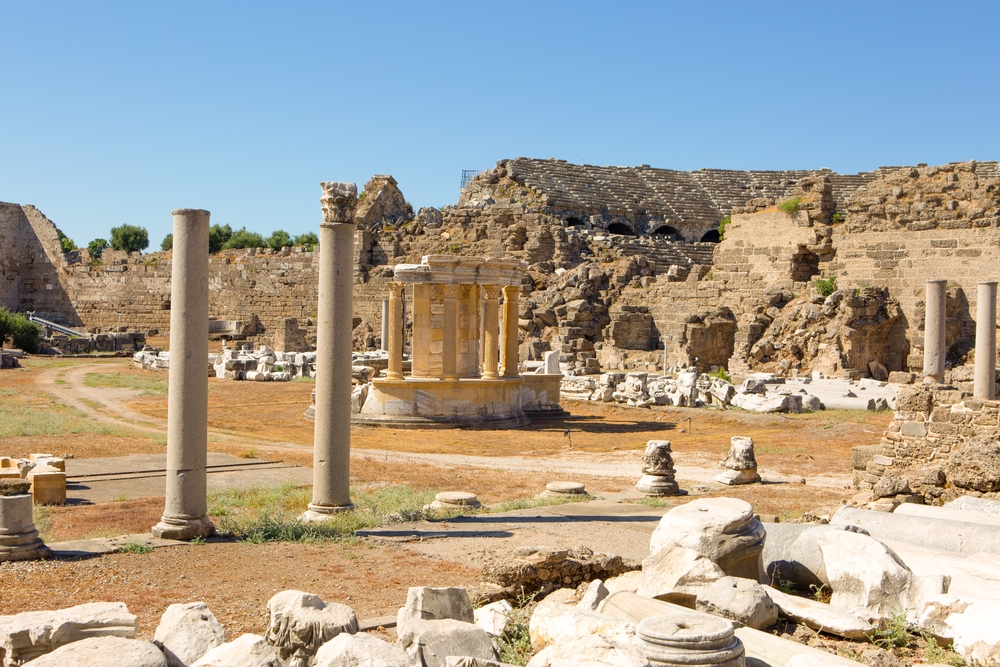
Aspendos, Turkey:
In Turkey’s Antalya province, Aspendos is famed for its remarkably preserved Roman theater, built in the 2nd century AD under Emperor Marcus Aurelius. This theater, known for its outstanding acoustics, can seat up to 20,000 people and is still used for performances today.
Established around 1000 BC, Aspendos boasts other significant ruins like a basilica, an agora, and an impressive Roman aqueduct. It remains an important tourist attraction, with many attending concerts and festivals in its ancient theater.
Tourist attractions and things to do in Aspendos, Turkey:
- Aspendos Theatre: This ancient Roman theatre, known for its remarkable state of preservation and superior acoustics, is considered one of the best-preserved theatres of antiquity. It is still used today for performances and festivals, providing a timeless experience for visitors.
- Aqueducts: The remnants of the Roman aqueducts that once supplied water to Aspendos are an impressive sight. They showcase the engineering feats of the ancient Romans.
- Basilica: The remains of the basilica offer insight into the Roman architectural style and provide a glimpse into the civic life of the ancient city.
- Agora: Aspendos’s ancient marketplace, or Agora, where merchants once sold their goods, gives visitors a sense of the day-to-day activities that would have taken place in the city.
- Aspendos International Opera and Ballet Festival: If timing allows, visitors can experience this annual festival held in the ancient theatre. It is a unique opportunity to enjoy classical performances in an authentic and historic setting.
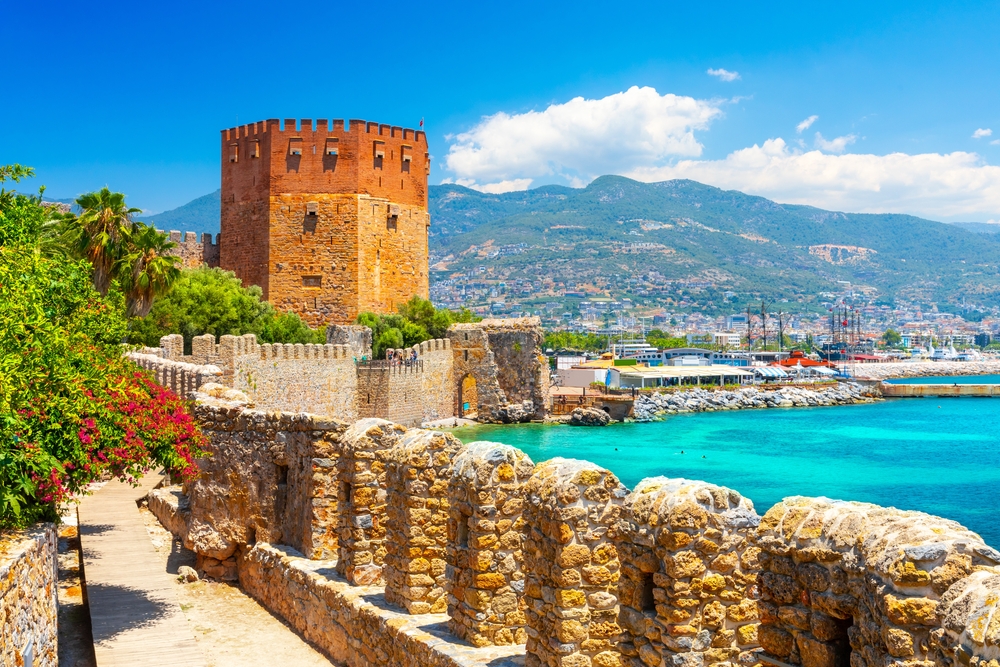
Alanya, Turkey:
Alanya is a popular tourist destination located on the southern coast of Turkey, nestled in the Antalya Province. Blessed with a Mediterranean climate, it boasts sun-kissed beaches, such as Kleopatra Beach, and turquoise waters that attract sunbathers and water sports enthusiasts alike.
The city’s rich history is evident in landmarks like the Alanya Castle, a Seljuk-era fortress overlooking the sea, and the Red Tower, a distinctive historical tower used for defense in the 13th century. The Damlatas Caves offer another attraction with their unique stalactites and stalagmites. Alanya offers vibrant nightlife, restaurants, and shopping avenues, making it a favorite among history buffs and holidaymakers.
Tourist attractions and things to do in Alanya, Turkey:
- Alanya Castle (Alanya Kalesi): A medieval fortress towering 250 meters above the sea on a rocky peninsula, it offers panoramic views of the coastline and the Taurus Mountains. Inside the walls are ruins of ancient homes, a cistern, and a Byzantine church.
- Damlatas Caves (Damlatas Magarasi): Discovered in 1948, these caves are known for their impressive stalactites and stalagmites. The high humidity and constant temperature are believed to have therapeutic properties, especially for asthma.
- Cleopatra Beach: Famed for its beautiful sandy beaches and clear waters, Cleopatra Beach is said to have been gifted to the Egyptian Queen Cleopatra by Mark Antony. It’s a perfect spot for sunbathing, swimming, and enjoying water sports.
- Red Tower (Kizil Kule): This octagonal tower is one of Alanya’s main landmarks. Built in the 13th century, it now houses an ethnographic museum and offers visitors a chance to learn about the region’s history.
- Sapadere Canyon: A natural attraction a bit further from Alanya, it offers a refreshing escape with its cool streams, waterfalls, and wooden walkways through the gorge. Visitors can explore the canyon’s rich biodiversity and enjoy a peaceful atmosphere away from the beach crowds.
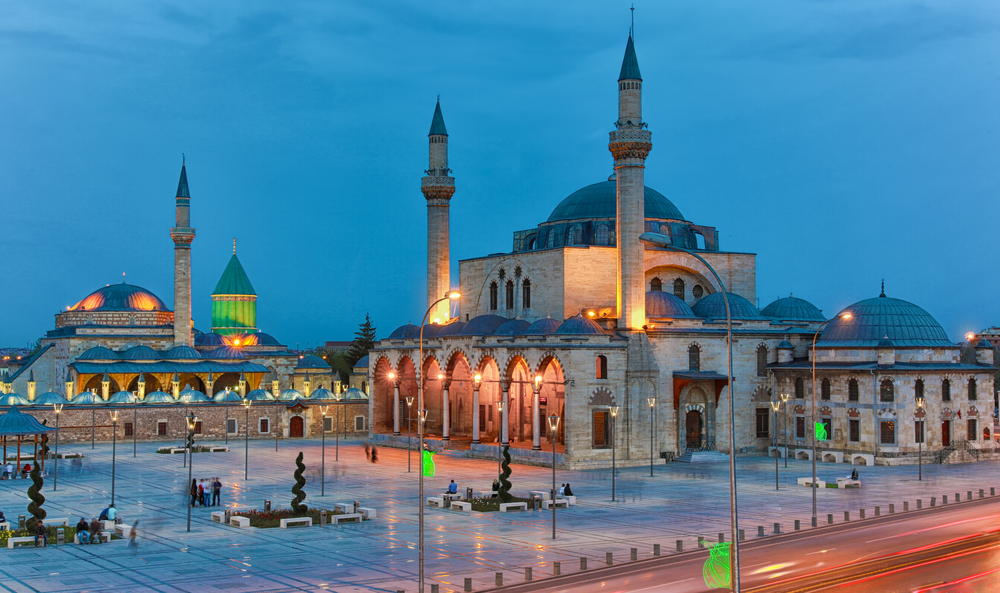
Konya, Turkey:
In Turkey’s Central Anatolia region, Konya is a city steeped in history and spiritual significance. Known as the birthplace of the mystical Sufi practice, it is most renowned for being the home of Rumi, the 13th-century poet and founder of the Whirling Dervishes. His mausoleum, the Mevlâna Museum, is a pilgrimage site for Sufis and admirers worldwide.
Every year, Konya hosts the Whirling Dervishes Festival, an event filled with mesmerizing spiritual dances and chants. The city also boasts Seljuk-era architectural masterpieces, like the Alaeddin Mosque and the İnce Minare Museum. Surrounded by the vast Anatolian steppe, Konya blends its deep-rooted spirituality with its historical ambiance, making it a unique and must-visit location in Turkey
Tourist attractions and things to do in Konya, Turkey:
- Mevlâna Museum (Mevlâna Müzesi): This museum, also known as the Green Mausoleum or the Mevlâna Tomb, is the final resting place of the Sufi mystic Rumi. It is one of the most important pilgrimage sites for Sufism and an essential visit for those interested in Rumi’s poetic and spiritual legacy.
- Selimiye Mosque: An elegant mosque commissioned by Sultan Selim II in the 16th century, the Selimiye Mosque is admired for its striking architecture and is an active place of worship.
- Alaaddin Hill (Alaeddin Tepesi): This hill in the city center is the site of the remains of the Seljuk Sultan’s palace and Alaeddin Mosque. It offers a pleasant park setting and panoramic views of Konya.
- Whirling Dervishes Ceremony: Konya is the birthplace of the whirling dervish practice, and visitors can witness the Sema ceremony, a transcendental experience of spinning in meditative remembrance of God.
- İnce Minareli Medrese: This 13th-century building, once a theological school, now serves as a museum of wooden and stone carving art. It is noted for its intricate façade featuring an impressive minaret with a uniquely slender and decorated appearance.
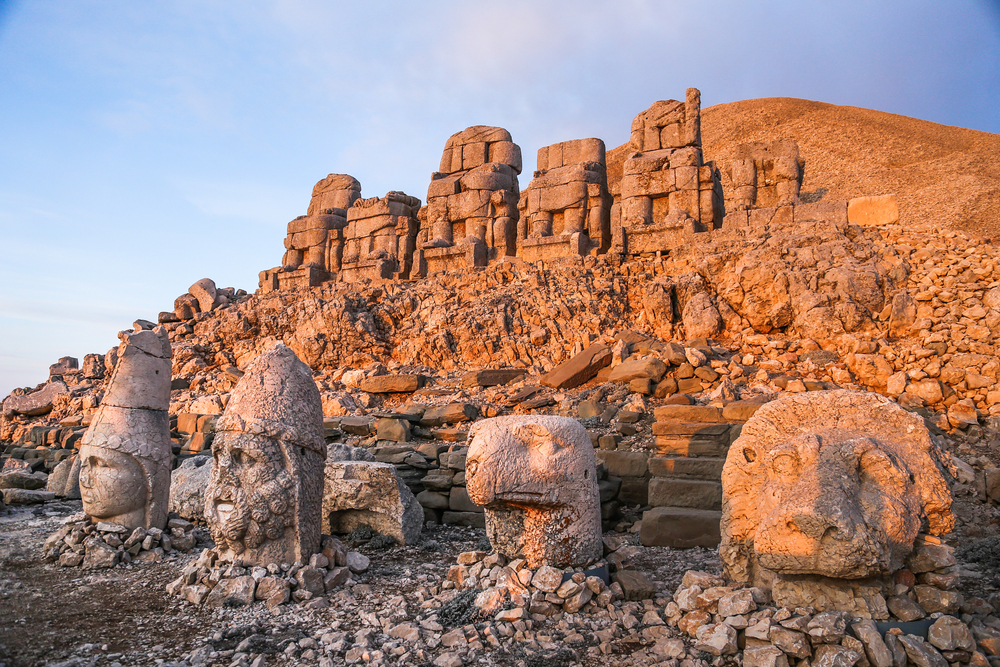
Mount Nemrut, Turkey:
Mount Nemrut, located in southeastern Turkey, is one of the country’s most intriguing archaeological sites and is recognized as a UNESCO World Heritage Site. Dominating the landscape with its elevation of over 2,100 meters, the mountain’s peak is famously adorned with a collection of colossal stone statues and a tumulus believed to be the burial site of King Antiochus I Theos of Commagene from the 1st century BC.
These statues, with heads measuring several meters in height, represent various Greco-Persian deities and the king himself. Time has taken its toll, causing the heads to detach from their bodies, now lying scattered on the ground. The site offers a breathtaking view, especially during sunrise and sunset, as golden hues illuminate the statues.
Tourist attractions and things to do in Mount Nemrut, Turkey:
- Giant Statues: The summit of Mount Nemrut is home to a collection of colossal statues representing gods and rulers of the Commagene Kingdom. The heads of these statues have fallen to the ground but remain an imposing sight.
- Hierotheseion: The statues and the royal tomb of King Antiochus I Theos of Commagene form what is known as the Hierotheseion, designed to be a sanctuary and a monumental tomb.
- Sunrise and Sunset Views: The site is famous for its breathtaking sunrises and sunsets. The scattered statue heads and the surrounding landscape are bathed in a golden hue, creating a mystical atmosphere.
- East and West Terraces: The complex is divided into two terraces, the east and west, which align with the solstices. Both terraces feature rows of statues and a large slab of stone called a stele, depicting King Antiochus I shaking hands with a god.
- Mountain Trek: To reach the summit where the statues stand, visitors undertake a trek that is both a physical challenge and a journey through history. The path offers scenic views of the surrounding Taurus Mountains.
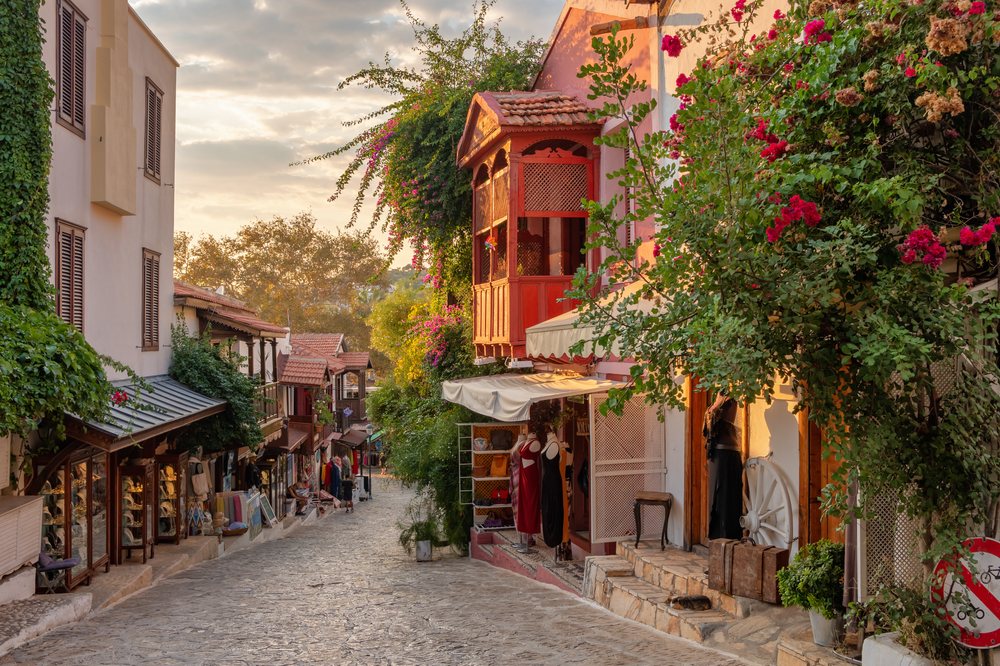
Kas, Turkey:
Kas, a picturesque coastal town in the Antalya Province of southwestern Turkey, is a gem on the Turquoise Coast. Once an unassuming fishing village, Kas has become a vibrant tourist destination while retaining its quaint and charming character. Nestled between the Taurus Mountains and the azure waters of the Mediterranean, the town offers a delightful mix of ancient ruins, like the Hellenistic theater and Lycian tombs, and modern amenities.
Its crystal-clear waters, rich with diverse marine life and intriguing underwater sites, including the sunken city of Kekova, draw divers. The town’s narrow streets, lined with whitewashed houses and bougainvillea, boast artisan shops, restaurants, and cozy cafes. Its harbor is lively, with boats offering trips to nearby islands and hidden bays.
Tourist attractions and things to do in Kas, Turkey:
- Kaputaş Beach: A stunning beach located in a cleft between cliffs, reached by stairs from the coastal road, known for its turquoise waters and as one of Turkey’s most photographed beaches.
- Ancient City of Patara: Close to Kaş, the ruins of Patara, including a well-preserved ancient theatre and lighthouse, offer a historical outing. Patara is also known for its long sandy beach, the birthplace of St. Nicholas.
- Kekova Sunken City: Accessible by boat tour from Kaş, Kekova is an ancient Lycian city partially submerged underwater. The boat trips offer views of the sunken structures through the clear waters.
- Lycian Rock Tombs: These ancient tombs are carved directly into the rock faces and cliffs in and around Kaş, telling the story of the ancient Lycian civilization and their burial traditions.
- Diving and Water Sports: Kaş is a hub for scuba diving, snorkeling, and other water sports, with a wealth of marine life and several interesting dive sites, including underwater canyons and wrecks.
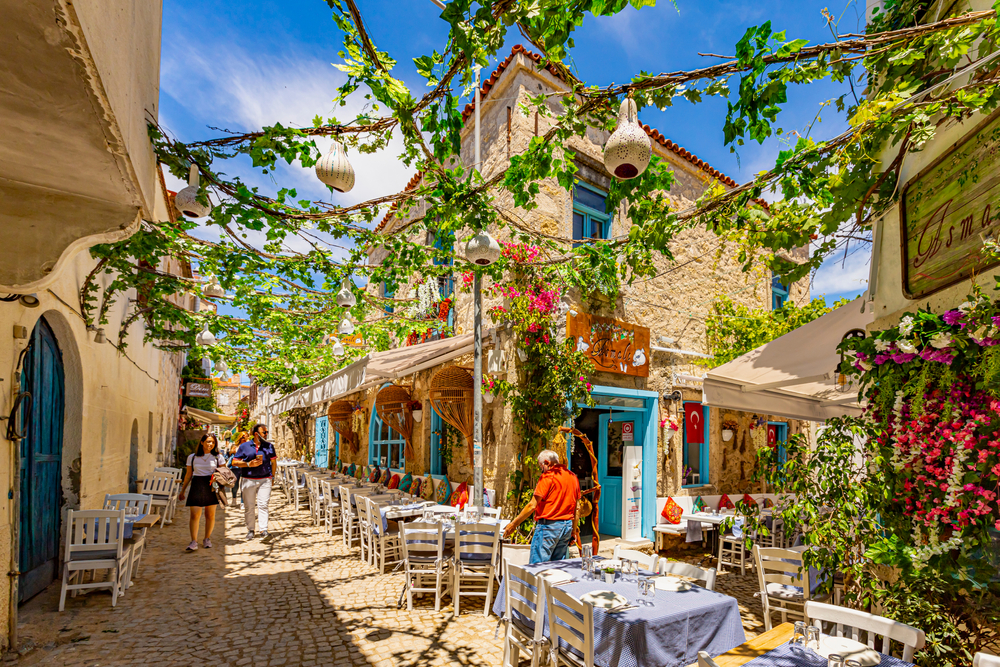
Izmir, Turkey:
Izmir, Turkey’s third-largest city, is on the western coast along the Aegean Sea. Often dubbed the “Pearl of the Aegean,” Izmir boasts a history that spans over 3,500 years, with traces of ancient Greek, Roman, Byzantine, and Ottoman civilizations. The city’s Konak Square is famous for the iconic Izmir Clock Tower, a gift from German Emperor Wilhelm II in the early 20th century.
The ancient Agora, once a bustling Roman bazaar, is a testament to its rich past. Modern Izmir is a hub of culture, commerce, and tourism, with a vibrant arts scene, bustling bazaars like Kemeraltı, and seaside promenades. Its proximity to ancient sites like Ephesus and Pergamon makes it a strategic starting point for explorations into Turkey’s historic landscapes.
Tourist attractions and things to do in Izmir, Turkey:
- Konak Square: The heart of the city, featuring the iconic Clock Tower, a historic symbol of Izmir. The square is a popular meeting place and offers a sense of the city’s bustling atmosphere.
- Kadifekale (Velvet Castle): The ruins of an ancient castle on a hill offer panoramic views of Izmir and the bay, providing a glimpse into the city’s past and a scenic spot for photos.
- Kemeraltı Market: This historical market is a maze of streets filled with shops, eateries, and coffeehouses. It’s a great place to sample local cuisine, shop for souvenirs, and soak up the vibrant local culture.
- Agora Open Air Museum: The remains of the ancient Agora of Smyrna, this open-air museum showcases well-preserved Roman and Greek ruins, including columns, arches, and a former basilica.
- Asansör (Elevator): Built in 1907 to ease passage from the narrow coastline to the hillside, the Asansör is a historic elevator offering great views from the top, along with a restaurant and café.



